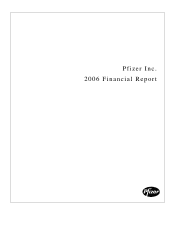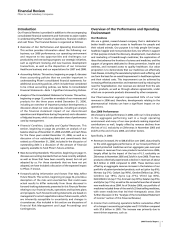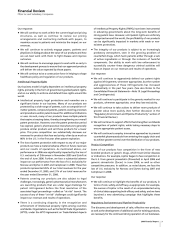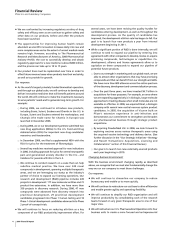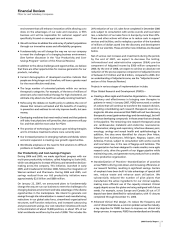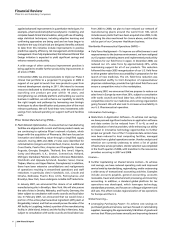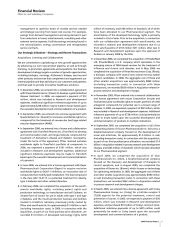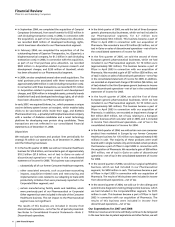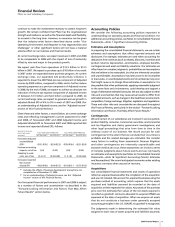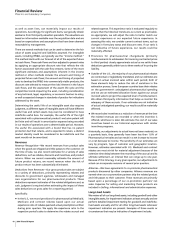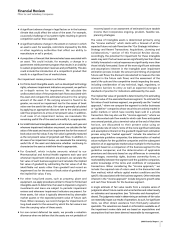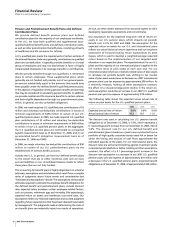Pfizer 2006 Annual Report Download - page 4
Download and view the complete annual report
Please find page 4 of the 2006 Pfizer annual report below. You can navigate through the pages in the report by either clicking on the pages listed below, or by using the keyword search tool below to find specific information within the annual report.
2 2006 Financial Report
Financial Review
Pfizer Inc and Subsidiary Companies
lower Acquisition-related in-process research and development
charges (IPR&D). In 2006, we incurred IPR&D expenses of $835
million, primarily related to our acquisitions of PowderMed
Ltd., and Rinat Neuroscience Corp. (Rinat), as compared with
IPR&D of $1.7 billion in 2005, primarily related to our
acquisitions of Vicuron Pharmaceuticals, Inc. (Vicuron) and Idun
Pharmaceuticals, Inc. (Idun).
lower asset impairment charges. In 2006, we expensed $320
million related to the impairment of our Depo-Provera
intangible asset while, in 2005, we expensed $1.2 billion
related to the impairment of our Bextra intangible asset.
a lower effective income tax rate. In 2006, our effective tax
rate on continuing operations of 15.3% was lower than the
29.4% rate in 2005, which largely reflected the impact of our
decision to repatriate approximately $37 billion of foreign
earnings to the United States in 2005.
(See further discussion in the “Analysis of the Consolidated
Statement of Income” section of this Financial Review.)
•
Discontinued operations—net of tax were $8.3 billion in 2006,
compared with $498 million in 2005. The results in both years
relate primarily to our Consumer Healthcare business, which was
sold on December 20, 2006. The 2006 amount includes the gain
on the sale of this business of approximately $7.9 billion, after
tax. (See further discussion in the “Our Strategic Initiatives—
Strategy and Recent Transactions: Dispositions” and “Analysis
of the Consolidated Statement of Income” sections of this
Financial Review.)
•
We completed a number of strategic acquisitions that we
believe will strengthen and broaden our existing pharmaceutical
capabilities. We acquired the worldwide rights to manufacture
and sell Exubera, an inhaled form of insulin, for about $1.4
billion. We also acquired two companies, PowderMed Ltd., a
U.K. company specializing in the emerging science of DNA-
based vaccines for the treatment of influenza and chronic viral
diseases, and Rinat, a biologics company with several new
central nervous system product candidates. (See further
discussion in the “Strategic Initiatives—Strategy and Recent
Transactions: Acquisitions, Licensing and Collaborations” section
of this Financial Review.)
•
We made significant progress with our Adapting to Scale (AtS)
productivity initiative, which is a broad-based, company-wide
effort to leverage our scale and strength more robustly and
increase our productivity. We realized approximately $2.6
billion in savings in 2006, exceeding our original savings goal
of about $2 billion for this period, while incurring related costs
of $2.1 billion in 2006 and $763 million in 2005. Building on
what had already been accomplished, we significantly expanded
the goals of this initiative in October 2006 and are now
targeting an absolute net reduction in the pre-tax expense
component of Adjusted income and the creation of a more
flexible cost structure. In addition to these cost-centered goals,
we have announced other priorities, such as maximizing
revenues from the current product portfolio, investing in
medium- and long-term growth opportunities through our
internal pipeline and externally-sourced products and creating
smaller, more focused and accountable operating units. (See
further discussion in the “Our Productivity and Cost Savings
Program” section of this Financial Review. For an understanding
of Adjusted income, see the “Adjusted Income” section of this
Financial Review.)
Our Operating Environment and Response to Key
Opportunities and Challenges
We and our industry are facing significant challenges in a
profoundly changing business environment and we are taking
steps to fundamentally change the way we run our business to
meet these challenges, as well as to take advantage of the diverse
and attractive opportunities that we see in the marketplace.
There are a number of industry-wide factors that may affect our
business and they should be considered along with the
information presented in the “Forward-Looking Information and
Factors That May Affect Future Results,” section of this Financial
Review. Such industry-wide factors include pricing and access,
intellectual property rights, product competition, the regulatory
environment and pipeline productivity and the changing business
environment.
Pricing and Access
We believe that our medicines provide significant value for both
healthcare providers and patients, not only from the improved
treatment of diseases, but also from a reduction in other
healthcare costs such as hospitalization or emergency room costs.
Notwithstanding the benefits of our products, the pressures from
governments and other payer groups are continuing and
increasing. These pressure points can include price controls, price
cuts (directly or by rebate actions) and regulatory changes that
limit access to certain medicines.
•
Governments around the world continue to seek discounts on
our products, either by leveraging their significant purchasing
power or by mandating prices or implementing price controls.
In the U.S., the enactment of the Medicare Prescription Drug
Improvement and Modernization Act of 2003 (the Medicare
Act), which went into effect in 2006, expanded access to
medicines to patients-in-need through prescription drug
benefits for Medicare beneficiaries. While expanded access
results in increased sales of our products, such increases could
be offset by increased pricing pressures in the future, due to
the enhanced purchasing power of the private sector providers
that negotiate on behalf of Medicare beneficiaries.
•
We have recently seen restrictive measures on access and
pricing taken by influential decision-makers in several large
European markets and the growing power of managed care
organizations in the U.S. has increased the pressure on
pharmaceutical prices and access.
•
A rise in consumer-directed health plans, as well as tiered co-
pay in managed care plans, has increased end-customer
sensitization to the cost of healthcare. Consumers have become
aware of global price differences that result from price controls
imposed by certain governments and have become more willing
to seek less expensive alternatives, such as sourcing medicines
across national borders, despite the increased risk of receiving
inferior or counterfeit products, and switching to generics.

